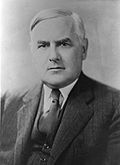| |||||||||||||||||
| |||||||||||||||||
Lonergan: 40–50% 50–60% 60-70% Bingham: 40–50% 50-60% 60-70% 70-80% 80-90% Tie: 50% | |||||||||||||||||
| |||||||||||||||||
| Elections in Connecticut |
|---|
 |
The 1932 United States Senate election in Connecticut was held on November 8, 1932. Incumbent Senator Hiram Bingham III ran for a second full term in office but was defeated by Democratic U.S. Representative Augustine Lonergan. This was the first time since 1879 that Democrats won this Senate seat, and the first since 1881 that they won either seat.
Contents
- Republican nomination
- Democratic nomination
- Candidates
- Campaign
- Convention
- General election
- Candidates 2
- Campaign 2
- Results
- See also
- References
This was despite the fact that Connecticut was one of only six states President Herbert Hoover carried in his landslide defeat by Franklin D. Roosevelt, Lonergan won the seat as one of eleven gains made by the Democrats in 1932.



